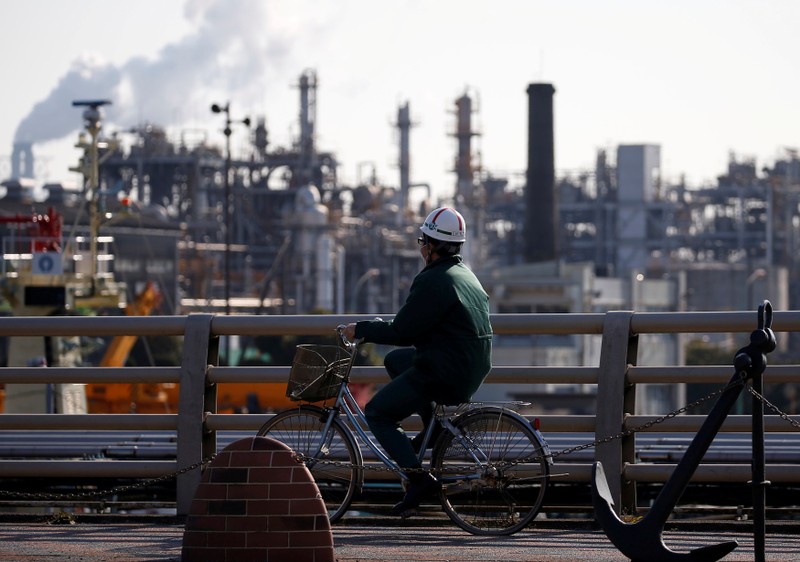
FILE PHOTO: A worker cycles near a factory at the Keihin industrial zone in Kawasaki, Japan February 28, 2017. REUTERS/Issei Kato/File Photo
September 30, 2019
By Daniel Leussink
TOKYO (Reuters) – Japan’s industrial output shrank more than expected in August in the latest warning that the economy and its manufacturers are facing intensifying pressure amid a bitter Sino-U.S. trade war.
Retail sales, however, expanded at a faster-than-expected pace, signaling strength in private spending ahead of October’s nationwide sales tax increase.
Industrial output fell 1.2% in August, government data showed, dropping at a faster pace than a median market forecast for a 0.5% decline and almost completely reversing July’s 1.3% increase.
Output was weighed down by reduced production of iron and steel products, factory production equipment and cars, offsetting a gain in electronic parts and chemicals, the data showed.
Manufacturers surveyed by the trade ministry expect output to rise 1.9% in September, but fall 0.5% in October.
Monday’s output data paints a bleak picture for Japan’s export-reliant economy, underlining broadening stress across the manufacturing sector from slowing global growth, though service-sector activity remains firm as it is less at risk from weakness in global trade.
“The lack of export growth because of the global economic slowdown is having a major impact,” said Takumi Tsunoda, senior economist at Shinkin Central Bank Research Institute. “The sales tax will be raised in October, so the deceleration of the economy will likely become stronger.”
The ministry cut its assessment of activity on the whole, saying it has been somewhat weakening recently.
The world’s third-largest economy has so far avoided buckling under a slowdown in overseas demand, growing for the third straight quarter in April-June, largely thanks to robust household consumption and public works spending.
The latest data showed Japan’s exports slipped for a ninth month in August as the Sino-U.S. trade war hit demand from China and other Asian trading partners. Exports in volume terms, which strips away the exchange rate impact, also fell.
Japanese Prime Minister Shinzo Abe, however, has brought Japanese exporters some relief after signing a limited trade deal with U.S. President Donald Trump to cut tariffs on U.S. farm goods, Japanese machine tools and other products.
Although the agreement does not cover autos, Abe said he had received assurances from Trump that Washington would not impose previously threatened “Section 232” national security tariffs on Japanese car imports.
Still, even as the threat of higher U.S. tariffs on Japanese car imports was staved off, policymakers remain worried about the darkening outlook for the economy in light of frail external demand and global recession risks.
This month, the Bank of Japan signaled the chance of expanding stimulus as early as its October policy meeting by stepping up its rhetoric against threats to the economy from heightened overseas risks.
An upbeat sign in August factory output came from electronic parts production, which expanded for a second straight month, suggesting the global IT cycle could be coming closer to bottoming out, said Shinkin’s Tsunoda.
“It usually expands for two to three years before getting worse for a year, and it has been contracting since around the fall of last year,” he said.
Separate data on Monday showed domestic demand might be stronger than thought, as retail sales climbed 2% in August from a year earlier, reflecting robust spending ahead of a sales tax increase to 10% from 8% on Oct. 1. The reading was better than a median estimate for a 0.9% gain.
(Reporting by Daniel Leussink; Editing by Gerry Doyle)

